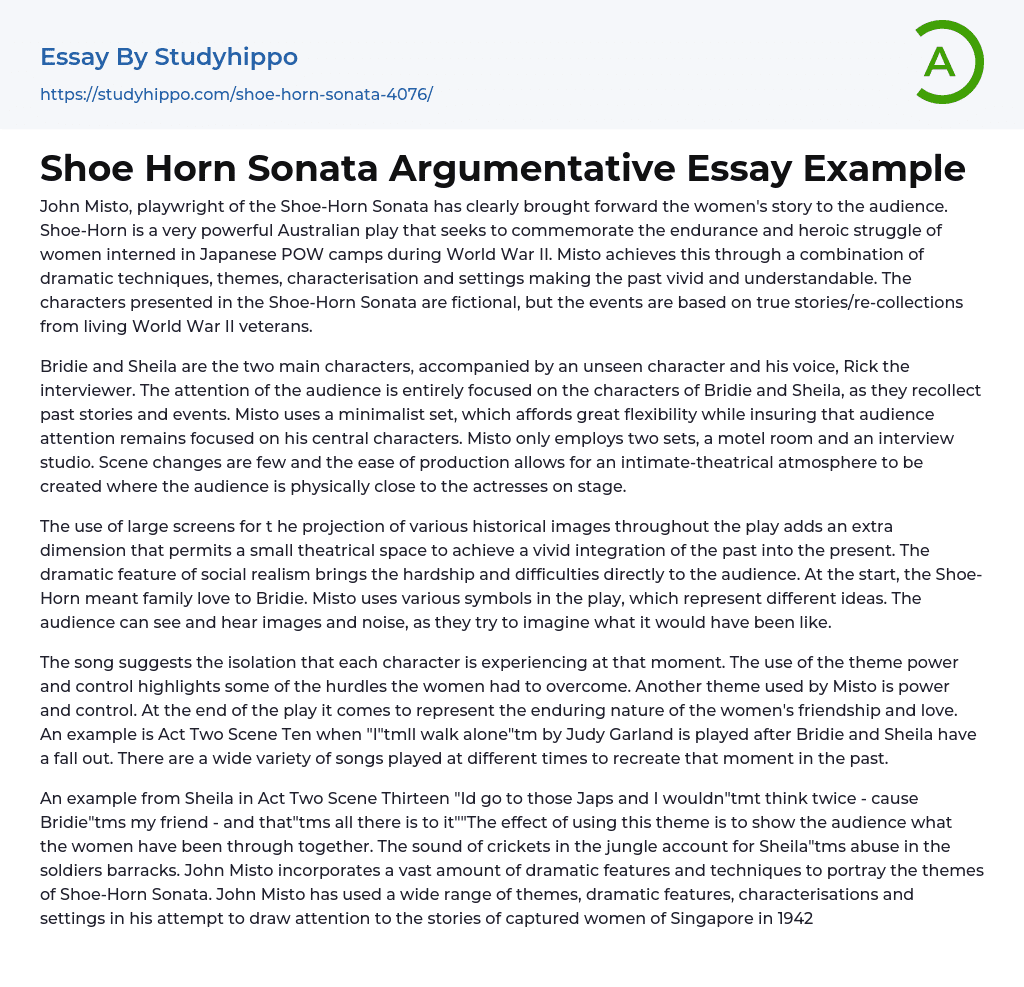John Misto, the playwright of the Shoe-Horn Sonata, skillfully conveys the women's narrative to the audience. This Australian play holds immense power as it aims to honor the strength and courageous fight of women held captive in Japanese POW camps during World War II. Misto effectively achieves this by utilizing various dramatic techniques, themes, character development, and settings, ultimately bringing the past to life and making it relatable. While the characters in the Shoe-Horn Sonata are fictional, the events portrayed are rooted in real-life accounts and memories shared by World War II veterans who are still living.
Bridie and Sheila are the two main characters, accompanied by an unseen character named Rick, who acts as the interviewer. The audience's attention is solely on Bridie and Sheila as they reminisce about past stories and events. Misto uses a minimalist set consisting of a
...motel room and an interview studio, allowing for flexibility without detracting from the focus on the central characters. Scene changes are minimal, creating an intimate-theatrical atmosphere where the audience is physically close to the actresses on stage.
The use of large screens during the play allows a small theatrical space to vividly integrate historical images into the present. The incorporation of social realism brings the audience face-to-face with the hardships and difficulties experienced. Initially, Bridie perceives the Shoe-Horn as a symbol of family love. Throughout the play, Misto employs various symbols that convey different ideas. By witnessing and hearing images and sounds, the audience is encouraged to imagine what it would have been like.
The song in the play signifies the isolation that each character is feeling at that time. It also emphasizes the challenges that
the women have faced in terms of power and control. Another theme explored by Misto is power and control. Towards the end of the play, this theme represents the enduring bond and affection among the women. For instance, in Act Two Scene Ten, when Bridie and Sheila have a disagreement, "I'll walk alone" by Judy Garland is played. Different songs are used throughout the play to recreate those historical moments.
An example from Sheila in Act Two Scene Thirteen "I'd go to those Japs and I wouldn't think twice - cause Bridie's my friend - and that's all there is to it"
The effect of using this theme is to show the audience what the women have been through together. The sound of crickets in the jungle account for Sheila's abuse in the soldier's barracks.
John Misto incorporates a vast amount of dramatic features and techniques to portray the themes of Shoe-Horn Sonata. John Misto has used a wide range of themes, dramatic features, characterizations, and settings in his attempt to draw attention to the stories of captured women of Singapore in 1942.
- Band essays
- Baroque Music essays
- Blues essays
- Classical Concert essays
- Classical Music essays
- Concert essays
- Hip Hop essays
- Jazz essays
- Ludwig Van Beethoven essays
- Michael Jackson essays
- Mp3 essays
- Music Concert Report essays
- Music Reference essays
- Music video essays
- Musical Instruments essays
- Opera essays
- Piano essays
- Popular music essays
- Recording essays
- Rock And Roll essays
- Rock Music essays
- Singing essays
- Sonata essays
- Song essays
- Sonnet essays
- Tupac shakur essays




